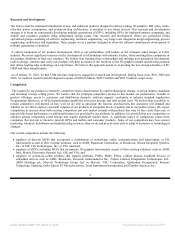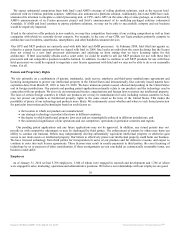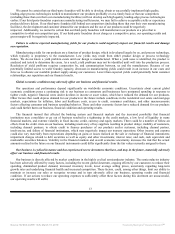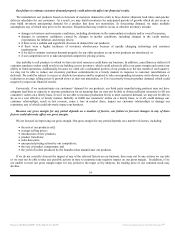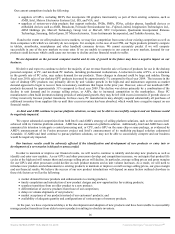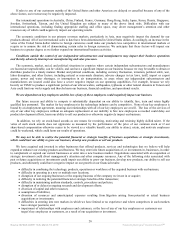NVIDIA 2010 Annual Report Download - page 25
Download and view the complete annual report
Please find page 25 of the 2010 NVIDIA annual report below. You can navigate through the pages in the report by either clicking on the pages listed below, or by using the keyword search tool below to find specific information within the annual report.
Our current competitors include the following:
• suppliers of GPUs, including MCPs that incorporate 3D graphics functionality as part of their existing solutions, such as
AMD, Intel, Matrox Electronics Systems Ltd., SIS, and VIA; and
• suppliers of system-on-a-chip products that support netbooks, PNDs, PMPs, PDAs, cellular phones, handheld devices or
embedded devices such as AMD, Broadcom, Freescale Semiconductor Inc., Fujitsu Limited, Imagination Technologies Ltd.,
ARM Holdings plc, Marvell Technology Group Ltd, or Marvell, NEC Corporation, Qualcomm Incorporated, Renesas
Technology, Samsung, Seiko-Epson, ST Microelectronics, Texas Instruments Incorporated, and Toshiba America, Inc.;
If and to the extent we offer products in new markets, we may face competition from some of our existing competitors as well as
from companies with which we currently do not compete. For example, in the case of our CPB, our Tegra products primarily compete
in tablets, smartbooks, smartphones and other handheld consumer devices. We cannot accurately predict if we will compete
successfully in any of the new markets we may enter. If we are unable to compete in our current or new markets, demand for our
products could decrease which could cause our revenue to decline and our financial results to suffer.
We are dependent on the personal computer market and its rate of growth in the future may have a negative impact on our
business.
We derive and expect to continue to derive the majority of our revenue from the sale or license of products for use in the desktop
personal computer, or PC, and notebook PC markets, including professional workstations. A reduction in sales of PCs, or a reduction
in the growth rate of PC sales, may reduce demand for our products. These changes in demand could be large and sudden. During
fiscal year 2010, sales of our desktop GPU products increased by approximately 1% compared to fiscal year 2009. The increase in the
sale of desktop GPU products was primarily driven by unit volume growth in the high-end and mainstream segments as market
demand appeared to begin to recover from recessionary conditions that began in the prior year. However, sales of our notebook GPU
products decreased by approximately 31% compared to fiscal year 2009. This decline was driven primarily by a combination of the
decline in unit demand and in average selling prices, or ASPs, due to increased competition in the marketplace. Since PC
manufacturers often build inventories during periods of anticipated growth, they may be left with excess inventories if growth slows or
if they incorrectly forecast product transitions. In these cases, PC manufacturers may abruptly suspend substantially all purchases of
additional inventory from suppliers like us until their excess inventory has been absorbed, which would have a negative impact on our
financial results.
As Intel and AMD continue to pursue platform solutions, we may not be able to successfully compete and our business would
be negatively impacted.
We expect substantial competition from both Intel’s and AMD’s strategy of selling platform solutions, such as the success Intel
achieved with its Centrino platform solution. AMD has also announced a platform solution. Additionally, Intel and AMD have each
announced its intention to integrate a central processing unit, or CPU, and a GPU on the same chip or same package, as evidenced by
AMD’s announcement of its Fusion processor project and Intel’s announcement of its multichip packaged solution codenamed
Arrandale. If AMD and Intel continue to pursue platform solutions, we may not be able to successfully compete and our business
would be negatively impacted.
Our business results could be adversely affected if the identification and development of new products or entry into or
development of a new market is delayed or unsuccessful.
In order to maintain or improve our financial results, we will need to continue to identify and develop new products as well as
identify and enter new markets. As our GPUs and other processors develop and competition increases, we anticipate that product life
cycles at the high end will remain short and average selling prices will decline. In particular, average selling prices and gross margins
for our GPUs and other processors could decline as each product matures and as unit volume increases. As a result, we will need to
introduce new products and enhancements to existing products to maintain or improve overall average selling prices, our gross margin
and our financial results. We believe the success of our new product introductions will depend on many factors outlined elsewhere in
these risk factors as well as the following:
• market demand for new products and enhancements to existing products;
• timely completion and introduction of new product designs and new opportunities for existing products;
• seamless transitions from an older product to a new product;
• differentiation of our new products from those of our competitors;
• delays in volume shipments of our products;
• market acceptance of our products instead of our customers' products; and
• availability of adequate quantity and configurations of various types of memory products.
In the past, we have experienced delays in the development and adoption of new products and have been unable to successfully
manage product transitions from older to newer products resulting in obsolete inventory.
16
Source: NVIDIA CORP, 10-K, March 18, 2010 Powered by Morningstar® Document Research℠


